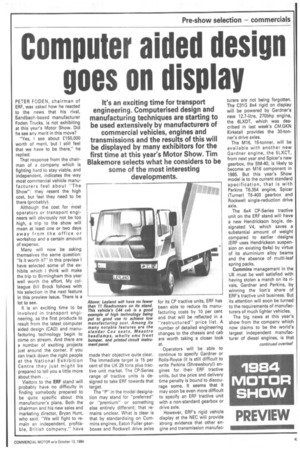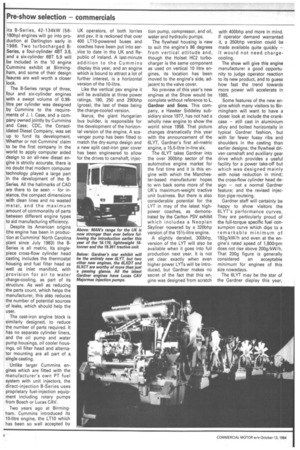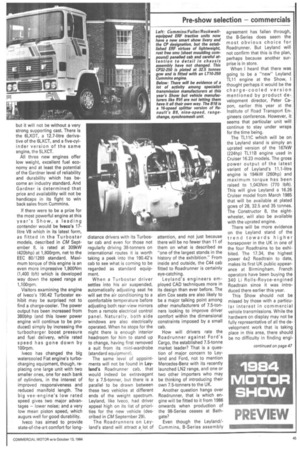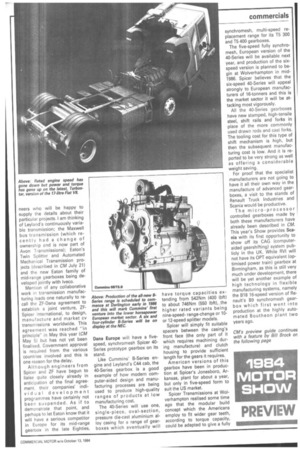Computer aided design goes on display
Page 45

Page 46

Page 47

Page 49

If you've noticed an error in this article please click here to report it so we can fix it.
It's an exciting time for transport engineering. Computerised design and manufacturing techniques are starting to be used extensively by manufacturers of commercial vehicles, engines and transmissions and the results of this will be displayed by many exhibitors for the first time at this year's Motor Show. Tim Blakem ore selects what he considers to be some of the most interesting developments.
PETER FODEN, chairman of ERF, was asked how he reacted to the news that his rival, Sandbach-based manufacturer Foden Trucks, is not exhibiting at this year's Motor Show, Did he see any merit in this move?
"Yes, I see about £150,000 worth of merit, but I still feel that we have to be there," he replied.
That response from the chairman of a company which is fighting hard to stay viable, and independent, indicates the way most commercial vehicle manufacturers feel about "The Show": they resent the high cost, but feel they need to be there (probably).
Although the cost for most operators or transport engineers will obviously not be too high, a trip to the show will mean at least one or two days away from the office or workshop and a certain amount of expense.
Many will now be asking themselves the same question: "Is it worth it?" In this preview I have selected some of the exhibits which I think will make the trip to Birmingham this year well worth the effort. My colleague Bill Brock follows with his selection in the next feature in this preview issue. There is a lot to see.
It is an exciting time to be involved in transport engineering, as the first products to result from the latest computer aided design (CAD) and manufacturing technology begin to come on stream. And there are a number of exciting projects just around the corner. If you can track down the right people at the National Exhibition Centre they just might be prepared to tell you a little more about them Visitors to the ERF stand will probably have no difficulty in finding somebody prepared to be quite specific about this manufacturer's plans. Both the chairman and his new sales and marketing director, Bryan Hunt, who said: "We will fight to remain an independent, profitable, British company," have Above: Leyland will have no fewer than 11 Roadrunners on its stand. This vehicle's C44 cab is a good example of high technology being put to good use to achieve low manufacturing cost. Among its many notable features are the slender Cox seats, Maestro headlamps, wholly smc front bumper, and printed circuit instrument panel.
made their objective quite clear. The immediate target is 15 per cent of the UK 28 tons plus tractive unit market. The CP-Series range of tractive units is designed to take ERF towards that target.
The "P" in the model designation may stand for "preferred" or "premium" or something else entirely different; that remains unclear. What is clear is that by standardising on Cummins engines, Eaton Fuller gearboxes and Rockwell drive axles for its CP tractive units, ERF has been able to reduce its manufacturing costs by 10 per cent and that will be reflected in a "restructured" price list. A number of detailed engineering changes to the chassis and cab are worth taking a closer look at.
Operators will be able to continue to specify Gardner or Rolls-Royce (it is still difficult to write Perkins (Shrewsbury)) engines for their ERF tractive units, but the price and delivery time penalty is bound to discourage some. It seems that it may soon be even more difficult to specify an ERF tractive unit with a non-standard gearbox or drive axle.
However, ERF's rigid vehicle display at the NEC will provide strong evidence that other engine and transmission manufac turers are not being forgotten. The C31G 8x4 rigid on display will be powered by Gardner's new 12.7-litre, 270bhp engine, the 6LXDT, which was described in last week's CM.GKN Kirkstall provides the 30-tonner's drive axles.
The M16, 16-tonner, will be available with another new Gardner engine, the 5LXCT, from next year and Spicer's new gearbox, the SM-40, is likely to become an M16 component in 1985. But this year's Show model is to the current standard specification, that is with Perkins T6.354 engine, Spicer (Turner) T6-400 gearbox and Rockwell single-reduction drive axle.
The 6x4 CP-Series tractive unit on the ERF stand will have a new Hendrickson bogie, designated V4, which saves a substantial amount of weight compared to earlier designs (ERF uses Hendrickson suspension on existing 6x4s) by virtue of its aluminium alloy beams and the absence of multi-leaf spring packs.
Cummins management in the UK must be well satisfied with having stolen a march on its rivals, Gardner and Perkins, by winning the lion's share of ERF's tractive unit business. But its attention will soon be turned to the requirements of manufacturers of much lighter vehicles.
The big news at this year's show from the company which now claims to be the world's largest independent manufacturer of diesel engines, is that its B-Series, 42-134kW (56180hp) engines will go into production at Darlington early in 1986. Two turbocharged BSeries, a four-cylinder 4BT 3.9, and a six-cylinder 66T 5.9 will be included in the 10 engine Cummins exhibit at Birmingham, and some of their design feaures are well worth a closer look.
The B-Series range of three, four and six-cylinder engines with a swept volume of 0.98litre per cylinder was designed by Cummins to the requirements of J. I. Case, and a company owned jointly by Cummins and Case; CDC, the Consolidated Diesel Company, was set up to fund its development. Whether or not Cummins' claim to be the first company in the world to apply computer aided design to an all-new diesel engine is strictly accurate, there is no doubt that modern computer technology played a large part in the development of the BSeries. All the hallmarks of CAD are there to be seen — for instance, the compact dimensions with clean lines and no wasted metal, and the maximum amount of commonality of parts between different engine types to aid manufacturing efficiency.
Despite its American origins (the engine has been in production at Cummins' North Carolina plant since July 1983) the BSeries is all metric. Its singlepiece cross-flow cylinder head casting includes the thermostat housing and fuel filter head as well as inlet manifold, with provision for air to water charge-cooling, as part of its structure. As well as reducing the parts count, which helps the manufacturer, this also reduces the number of potential sources of leaks, which should help the user.
The cast-iron engine block is similarly designed, to reduce the number of parts required. It has no separate cylinder liners, and the oil pump and water pump housings, oil cooler housings, oil filter head and alternator mounting are all part of a, single casting.
Unlike larger Cummins engines which are fitted with the manufacturer's own PT fuel system with unit injectors, the direct-injection B-Series uses proprietary fuel-injection equipment including rotary pumps from Bosch or Lucas CAV.
Two years ago at Birmingham. Cummins introduced its 10-litre engine, the LT10 which has been so well accepted by UK operators, of both lorries and psv. It is reckoned that over 400 LT10-powered buses and coaches have been put into service to date in the UK and Republic of Ireland. A last-minute addition to the Cummins display this year, and an engine which is bound to attract a lot of further interest, is a horizontal version of the 10-litre.
Like the vertical psv engine it will be available at three power ratings, 180, 250 and 290bhp (gross), the last of these being the charge-cooled version.
lkarus, the giant Hungarian bus builder, is responsible for the development of the horizontal version of the engine. A scavenger pump has been fitted to match the dry-sump design and a new split cast-iron gear cover has been engineered to allow for the drives to camshaft, injec tion pump, compressor, and oil, water and hydraulic pumps.
The flywheel housing is new to suit the engine's 86 degrees from vertical attitude and, though the Holset HC2 turbocharger is the same component as used on vertical 10 litre engines, its location has been moved to the engine's side, adjacent to the valve cover.
No preview of this year's new engines at the Show would be complete without reference to L. Gardner and Sons. This company, a Hawker Siddeley subsidiary since 1977, has not had a wholly new engine to show the world since 1958. That picture changes dramatically this year with the announcement of the 6LYT, Gardner's first all-metric engine, a 15.5-litre in-line six.
The 6LYT takes Gardner into the over 300bhp sector of the automotive engine market for the first time and it is this engine with which the Manchester-based manufacturer hopes to win back some more of the UK's maximum-weight tractive unit business. But there is also considerable potential for the LYT in may of the latest highpower coaches, as demonstrated by the Carlton PSV exhibit which includes a NeapIan Skyliner oowered by a 320bhp version of the 151/2-litre engine.
A slightly derated, 300bhp, version of the LYT will also be available when it goes into full production next year. It is not yet clear exactly when even higher power LYTs will be introduced, but Gardner makes no secret of the fact that this en; gine was designed from scratch
with 400bhp and more in mind. If operator demand warranted it, a 350bhp version could be made available quite quickly — it would not need chargecooling.
The show will give this engine manufacturer a good opportunity to judge operator reaction to its new product, and to guess how fast the trend towards more power will accelerate in 1985.
Some features of the new engine which many visitors to Birmingham will want to have a closer look at include the crankcase — still cast in aluminium alloy and bolted horizontally in typical Gardner fashion, but with far fewer fussy ribs and shoulders in the casting than earlier designs; the flywheel driven camshaft and auxiliary gear drive which provides a useful facility for a power take-off but which was designed mainly with noise reduction in mind; the cross-flow cylinder head design — not a normal Gardner feature; and the revised injection pipe routeing.
Gardner staff will certainly be happy to show visitors the 6LYT's performance curves. They are particularly proud of the full-torque specific fuel consumpion curve which dips to a remarkable minimum of 192g/kW/h and even at the engine's rated speed of 1,800rpm does not rise above 200g/kW/h. That 200g figure is generally considered an acceptable minimum for engines of this size nowadays.
The 6LYT may be the star of the Gardner display this year, but it will not be without a very strong supporting cast. There is the 6LXDT, a 12.7-litre derivative of the 6LXCT, and a five-cylinder version of the same engine, the 5LXCT.
All three new engines offer low weight, excellent fuel economy and at least the potential of the Gardner level of reliability and durability which has become an industry standard. And Gardner is determined that price and availability will not be handicaps in its fight to win back sales from Cummins.
If there were to be a prize for the most powerful engine at this year's Show, a leading contender would be Iveco's 17litre V8 which in its latest form, as fitted in the Turbostar models, described in CM September 8, is rated at 309kW (420bhp) at 1,800rpm, net to the EEC 80/1269 standard. Maximum torque of this engine is an even more impressive 1,900Nm (1,400 lbft) which is developed way down the speed range at 1,10Orpm.
Visitors examining the engine of Iveco's 190.42 Turbostar exhibit may be surprised not to find a charge-cooler. The power output has been increased from 380bhp (and this lower power engine will continue to be produced) simply by increasing the turbocharger boost pressure and fuel delivery, while rated speed has gone down by 10Orpm.
lveco has changed the big watercooled Fiat engine's turbocharging equipment, though, replacing one large unit with two smaller ones, one for each bank of cylinders, in the interest of improved responsiveness and reduced manifold length. The big vee-engine's low rated speed gives two major advantages — lower noise; and a very low mean piston speed, which augurs well for good durability.
lveco has aimed to provide state-of-the-art comfort for long distance drivers with its Turbostar cab and even for those not regularly driving 38-tonners on international routes it is worth taking a peek into the 190.42's cab to see what is coming to be regarded as standard equipment.
When a Turbostar driver settles into his air suspended, automatically adjusting seat he will set the air conditioning to a comfortable temperature before adjusting both rear-view mirrors from a remote electrical control panel. Naturally, both side windows are also electrically operated. When he stops for the night there is enough interior headroom for him to stand up to change, having first removed a suit from its mini-wardrobe (standard equipment).
The same level of appointments will not be found in Leyland's Roadrunner cab, that would indeed be extravagant for a 7.5-tonner, but there is a parallel to be drawn between these two vehicles at different ends of the weight spectrum. Leyland, like lveco, had driver appeal high on its list of priorities for the new vehicle (described in CM September 29).
The Roadrunners on Leyland's stand will attract a, lot of attention, and not just because there will be no fewer than 11 of them on what is described as "one of the largest stands in the history of the exhibition." From inside and outside, the C44 cab fitted to Roadrunner is certainly eye-catching.
Leyland's engineers employed CAD techniques more in its design than ever before. The slim Cox seats are also likely to be a major talking point among other manufacturers of 7.5-tonners looking to improve driver comfort within the dimensional constraints imposed by a small cab.
How will drivers rate the Roadrunner against Ford's Cargo, the established 7.5-tonne market leader? That is a question of major concern to Leyland and Ford, not to mention Mercedes-Benz with its recently launched LN2 range, and one or two other importers who may be thinking of introducing their own 7.5-tonners to the UK.
Another question hangs over Roadrunner, that is which engine will be fitted to it from 1986 onwards when production of the 98-Series ceases at Bathgate?
Even though the Leyland/Cummins, B-Series assembly agreement has fallen through, the B-Series does seem the most obvious choice for Roadrunner. But Leyland will not confirm that this is the plan, perhaps because another surprise is in store.
When I heard that there was going to be a "new" Leyland TL11 engine at the Show, I thought perhaps it would be the charge-cooled version mentioned by product de velopment director, Peter Capon, earlier this year at the Institute of Road Transport Engineers conference. However, it seems that particular unit will continue to stay under wraps for the time being.
The TL11C which will be on the Leyland stand is simply an uprated version of the 167kW (224hp) TL11B engine used in Cruiser 16.23 models. The gross power output of the latest variant of Leyland's 11.1-litre engine is 194kW (260hp) and maximum torque has been raised to 1,043Nm (770 lbft). This will give Leyland a 16.26 Cruiser model from March 1985 that will be available at plated gcws of 28, 32.5 and 35 tonnes.
The Constructor 8, the eightwheeler, will also be available with the uprated engine.
There will be more evidence on the Leyland stand of the trend towards higher horsepower in the UK in one of the four Roadtrains to be exhi bited. The 17.34, the highest power 4x2 Roadtrain to date, makes its first UK public appear ance at Birmingham. French operators have been buying the 340 Li Rolls-Royce-engined Roadtrain since it was introduced there earlier this year.
This Show should not be missed by those with a particu lar interest in commercial vehicle transmissions. While the hardware on display may not be fully representative of all the development work that is taking place in this area, there should be no difficulty in finding engi
neers who will be happy to supply the details about their particular projects. I am thinking of Leyland's continuously variable transmission; the Maxwell bus transmission (which recently had a change of ownership and is now part of Avon -Transmissions); Eaton's Twin Splitter and Automated Mechanical Transmission projects (described in CM July 21)
and the new Eaton family of mid-range gearboxes being de veloped jointly with lveco. Mention of any collaborative work in transmission manufacturing leads one naturally to recall the ZF-Dana agreement to establish a joint venture, ZFSpicer International, to design, manufacture and market cv transmissions worldwide. This agreement was reached "in principle" in May this year (CM May 5) but has not yet been finalised. Government approval is required from the various countries involved and this is one reason for the delay.
Although engineers from Spicer and ZF have begun to liaise quite closely already in anticipation of the final agreement, their companies' individual development programmes have certainly not been suspended. As if to demonstrate that point, and perhaps to let Eaton know that it will have a serious competitor in Europe for its mid-range gearbox in the late Eighties, Dana Europe will have a fivespeed, synchromesh Spicer 40Series prototype gearbox on its stand.
Like Cummins' B-Series engine and Leyland's C44 cab, the 40-Series gearbox is a good example of how modern computer-aided design and manufacturing processes are being used to produce high-quality ranges of products at low manufacturing cost.
The 40-Series will use one, single-piece, oval-section, pressure die-cast aluminium alloy casing for a range of gearboxes which eventually will have torque capacities extending from 542Nm (400 Ibft) to about 746Nm (550 lbft), .the higher rated variants being nine-speedrange-change or 10or 12-speed splitter models.
Spicer will simply fit suitable spacers between the casing's front face (the only part of it which requires machining during manufacture) and clutch housing to provide sufficient length for the gears it requires.
American versions of this gearbox have been in production at Spicer's Jonesboro, Arkansas, plant for about a year, but only in five-speed form to suit the US market.
Spicer Transmissions at Wolverhampton realised some time ago that the modular build concept which the Americans employ to fit wider gear teeth, according to torque capacity, could be adapted to give a fully synchromesh, multi-speed replacement range for its T5 300 and T5 400 gearboxes.
The five-speed fully synchromesh, European version of the 40-Series will be available next year, and production of the sixspeed version is planned to begin at Wolverhampton in mid1986. Spicer believes that the six-speed 40-Series will appeal strongly to European manufacturers of 16-tonners and this is the market sector it will be attacking most vigorously.
All the 40-Series gearboxes have new stamped, high-tensile steel, shift rails and forks in place of the more commonly used drawn rods and cast forks. The tooling cost for this type of shift mechanism is high, but then the subsequent manufacturing cost is low. And it is reported to be very strong as well as offering a considerable weight saving.
For proof that the specialist manufacturers are not going to have it all their own way in the manufacture of advanced gearboxes, a visit to the stands of Renault Truck Industries and Scania would be productive.
The micro-processor controlled gearboxes made by both these manufacturers have already been described in CM. This year's Show provides Scania with its first opportunity to show off its CAG (computeraided gearshifting) system publicly in the UK. While RVI will not have its OPT equivalent (optimised power train) gearbox at Birmingham, as this is still very much under development, there will be yet another example of high technology in flexible manufacturing systems, namely the B18 16-speed version of Renault's B9 synchromesh gearbox which first went into production at the highly automated Boutheon plant two years ago.
















































































































































